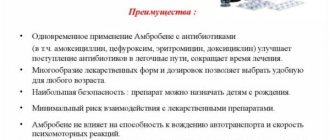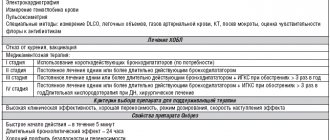Buy Onbrez Breezhaler capsules for inhalation 150 mcg No. 30 + inhaler in pharmacies
Onbrez Breezhaler Buy Onbrez Breezhaler in pharmacies Onbrez Breezhaler in the medicine directory DOSAGE FORMS capsules with powder for inhalation 150 µg
MANUFACTURERS Novartis Pharma Stein AG (Switzerland)
GROUP Bronchodilators - beta-agonists
COMPOSITION Active substance: indacaterol 150 mcg.
INTERNATIONAL NON-PROPENTED NAME Indacaterol
PHARMACOLOGICAL ACTION Indacaterol is a selective long-acting 2-adrenergic receptor agonist (within 24 hours) with a single dose. The pharmacological action of β2-adrenergic receptor agonists, including indacaterol, is associated with stimulation of intracellular adenylate cyclase, an enzyme that catalyzes the conversion of ATP to cyclic 3′,5′-adenosine monophosphate (cyclic AMP). An increase in cyclic AMP content leads to relaxation of bronchial smooth muscles. Indacaterol is an almost complete 2-adrenergic receptor agonist; the stimulating effect of the drug on 2-adrenergic receptors is 24 times stronger than on 1-adrenergic receptors, and 20 times stronger than on 3-adrenergic receptors. After inhalation, the drug has a rapid and long-lasting bronchodilator effect. Provides a sustained significant improvement in lung function (increased forced expiratory volume in the first second, FEV1) for 24 hours. The maximum effect is observed 2-4 hours after inhalation. When using indacaterol, there was no dependence of the bronchodilator effect on the time of inhalation of the drug during the day (morning or evening). Reduces dynamic and static hyperinflation (increased lung volumes at the end of spontaneous expiration) in patients with moderate and severe COPD. When using the drug, there is a statistically significant increase in inspiratory capacity and FEV1, a decrease in shortness of breath, and an improvement in exercise tolerance. After single or repeated inhalations, the average time to reach maximum concentration in the blood serum is about 15 minutes. After a single inhalation, the absolute bioavailability of indacaterol is about 43%. Systemic exposure results from absorption of the drug in the lungs and intestines. Serum concentration increases with repeated use of the drug. Of the metabolites of the drug in the blood serum, the hydroxylated derivative of indacaterol is determined to the greatest extent. Next, hydroxylated indacaterol and phenolic O-glucuronide of indacaterol predominate. Later, diastereomers of the hydroxylated derivative, indacaterol N-glucuronide, and C- and N-dealkylated products are detected. UGT1A1 is the only isoenzyme that metabolizes indacaterol to the phenolic O-glucuronide. Hydroxylation of indacaterol occurs mainly via the CYP3A4 isoenzyme. It has also been established that indacaterol is a substrate for the membrane transporter of P-glycoprotein (P-gp) molecules, but has low affinity. The amount of unchanged indacaterol excreted in the urine is less than 2% of the dose. Renal clearance of indacaterol averaged 0.46-1.20 l/h. Considering that the serum clearance of indacaterol is 23.3 L/h, it is obvious that excretion of the drug through the kidneys is insignificant (approximately 2-5% of systemic clearance). When taken orally, indacaterol was excreted mainly through the intestines (90% of the dose): unchanged (54% of the dose) and in the form of hydroxylated metabolites (23% of the dose).
INDICATIONS FOR USE Long-term maintenance therapy of bronchial obstruction in patients with COPD.
CONTRAINDICATIONS Age under 18 years (efficacy and safety have not been established); pregnancy; breastfeeding period; hypersensitivity to any of the components of the drug. The drug should be prescribed with caution to patients with concomitant cardiovascular disorders (coronary artery disease, acute myocardial infarction, arrhythmias, arterial hypertension), with convulsive disorders, thyrotoxicosis, diabetes mellitus, as well as in patients with a history of inadequate response to the action of 2-adrenergic receptor agonists .
SIDE EFFECTS When using the drug in therapeutic doses, the following adverse events were most often observed: nasopharyngitis, cough, upper respiratory tract infections and muscle spasms. Most of the above-mentioned adverse events were mild or moderate in severity, the incidence of these adverse events decreased with further use. From the respiratory system: often - cough, sore throat, rhinorrhea. From the musculoskeletal system: often - muscle spasm, myalgia, bone pain. From the nervous system: infrequently - dizziness, paresthesia. From the cardiovascular system: often - ischemic heart disease; infrequently - atrial fibrillation. From the digestive system: often - dry mouth. Metabolic disorders: often - hyperglycemia/newly diagnosed diabetes mellitus. General disorders: often - peripheral edema, pain in the chest (non-cardiogenic); infrequently - discomfort in the chest area. In clinical studies, within 15 seconds after inhalation of the drug, patients (in 17-20% of cases) developed a sporadic cough lasting about 5 seconds. The occurrence of cough after inhalation of the drug slightly bothered patients and did not require discontinuation of treatment with the drug (since cough is a symptom of COPD, and only in 6.6% of cases patients associated cough with the use of the drug). There was no connection between cough observed immediately after inhalation of the drug and the development of bronchospasm, exacerbation of COPD, worsening of COPD and decreased effectiveness of the drug.
INTERACTIONS Drugs that prolong the QT interval. As with the use of other β2-adrenergic receptor agonists, QT interval prolongation is possible during drug therapy. Since this effect of indacaterol on the length of the QT interval may be potentiated by other drugs, the drug should be administered with caution to patients receiving MAO inhibitors, tricyclic antidepressants, or other drugs that prolong the QT interval. Prolongation of the QT interval increases the risk of developing ventricular arrhythmia. Sympathomimetic drugs. Concomitant use of indacaterol with sympathomimetics (either alone or as part of combination therapy) may increase the risk of adverse events. The drug should not be used simultaneously with other long-acting β2-adrenergic receptor agonists or with drugs containing long-acting β2-adrenergic receptor agonists. Hypokalemia. Concomitant use with methylxanthine derivatives, corticosteroids or diuretics that remove potassium may enhance possible hypokalemia caused by 2-adrenergic receptor agonists. 2-adrenergic receptor blockers. Since β2-adrenergic blockers may weaken the effect or interfere with the action of β2-adrenergic agonists, Onbrez® Breezhaler® should not be used concomitantly with β2-adrenergic blockers (including eye drops). If it is necessary to use both classes of drugs, it is preferable to use cardioselective 2-adrenergic receptor blockers, however, they must be used with caution. Interaction at the level of the CYP3A4 isoenzyme and the membrane transporter P-glycoprotein. The interaction of indacaterol with specific inhibitors of the CYP3A4 isoenzyme and P-glycoprotein, such as ketoconazole, erythromycin and verapamil, has been studied. Concomitant use of indacaterol with verapamil resulted in a 1.4-2-fold increase in AUC and a 1.5-fold increase in maximum concentration. When using indacaterol with erythromycin, there was an increase in AUC by 1.4 - 1.6 times and maximum concentration by 1.2 times. Combination therapy with indacaterol and ketoconazole caused a 2-fold and 1.4-fold increase in AUC and maximum concentration, respectively. This increase in exposure due to drug interactions did not lead to a change in the safety profile. No drug interactions were observed when indacaterol was used with other drugs. In vitro studies have shown that indacaterol has little potential for interaction with drugs at the level of enzyme metabolism or at the level of membrane transporters with systemic exposure achieved at therapeutic doses.
METHOD OF APPLICATION AND DOSAGE For inhalation use only! Inhalation of the drug is carried out daily, once a day at the same time. The recommended dose of the drug is 150 mcg (contents of 1 capsule 150 mcg) 1 time per day (1 inhalation per day). The dose of the drug can be increased only on the recommendation of a doctor.
OVERDOSE Symptoms: after a single use of the drug in patients with COPD at a dose 10 times higher than the maximum therapeutic dose, a moderate increase in heart rate, an increase in blood pressure and a prolongation of the QTc interval were observed. The most likely symptoms of a drug overdose are tachycardia, tremor, palpitations, headache, nausea, vomiting, drowsiness, ventricular arrhythmia, metabolic acidosis, hypokalemia and hyperglycemia (caused by increased systemic beta2-adrenomimetic action). Treatment: supportive and symptomatic therapy is indicated. In severe cases, patients must be hospitalized. If necessary, it is possible to use cardioselective beta-blockers. Cardioselective beta-blockers should be used with caution, only under strict medical supervision, since their use can provoke the development of bronchospasm.
SPECIAL INSTRUCTIONS Bronchial asthma. Due to the lack of data on the long-term use of indacaterol in patients with bronchial asthma, the drug should not be used in this category of patients. Paradoxical bronchospasm. Like any other inhalation therapy, the use of the drug can lead to the development of paradoxical bronchospasm, which poses a threat to the patient's life. If paradoxical bronchospasm occurs, treatment with the drug should be immediately discontinued and alternative therapy should be prescribed. Worsening of the underlying disease. The drug cannot be used to relieve acute bronchospasm, i.e. Do not use as emergency therapy. If the course of COPD worsens during treatment with the drug, it is necessary to re-evaluate the patient’s condition and revise the treatment regimen for the disease. Effect on the cardiovascular system. In some patients, the drug, like other 2-adrenergic receptor agonists, can affect the cardiovascular system (increase heart rate, blood pressure). If adverse events occur, it may be necessary to discontinue drug therapy. In addition, the following electrocardiographic changes may be observed when beta-2 adrenergic agonists are used: T wave flattening, QT prolongation, and ST segment depression (however, the clinical significance of these changes has not been established). When using the drug in clinical studies (in recommended therapeutic doses), no significant prolongation of the QT interval was observed compared to placebo. Hypokalemia. Some patients may experience significant hypokalemia when using β2-adrenergic agonists, leading to the development of adverse effects from the cardiovascular system. A decrease in serum potassium concentration is usually transient and does not require correction. In patients with severe COPD, hypokalemia may be exacerbated by hypoxia and concomitant therapy, which in turn may increase the likelihood of developing arrhythmias. Hyperglycemia. Inhalation of high doses of 2-adrenergic receptor agonists may increase plasma glucose levels. When using the drug in patients with diabetes mellitus, the concentration of glucose in the blood plasma should be regularly monitored. In clinical studies, patients receiving the drug (in recommended doses) experienced an increase in the incidence of clinically significant hyperglycemia by an average of 1-2% compared to placebo.
STORAGE CONDITIONS The drug should be stored in a dry place, out of reach of children, at a temperature not exceeding 30 C.
Side effects
Most common adverse reactions:
- nasopharyngitis , sinusitis ;
- sore throat, nasal discharge;
- cough;
- dry mouth;
- muscle spasms, muscle and bone pain;
- tachycardia , ischemic heart disease ;
- hyperglycemia;
- peripheral edema.
Less common adverse reactions:
- dizziness;
- atrial fibrillation;
- paresthesia;
- discomfort in the chest.
Interaction
The effect on the length of the QT is potentiated by tricyclic antidepressants and MAO . Prolongation of the QT carries a risk of ventricular arrhythmia .
Concomitant use with sympathomimetics increases the risk of adverse reactions.
Cannot be used with other β2-adrenergic receptor agonists .
Hypokalemia is enhanced by simultaneous use of corticosteroids methylxanthine derivatives , and diuretics.
β2-adrenergic receptor blockers (including eye drops) weaken the effect of the drug. Concomitant use with verapamil , erythromycin , and ketoconazole leads to an increase in Cmax .
Overdose
Symptoms of overdose appeared when taking a dose 10 times the therapeutic dose. At the same time, there was an increase in heart rate , blood pressure and changes in the ECG in the form of prolongation of the QT .
The most common symptoms of overdose: tachycardia , palpitations, ventricular arrhythmia , tremor , headache , drowsiness , nausea, vomiting, hypokalemia and hyperglycemia .
Symptomatic therapy is indicated. Use beta-blockers (cardioselective) with caution, since their use sometimes provokes bronchospasm .


